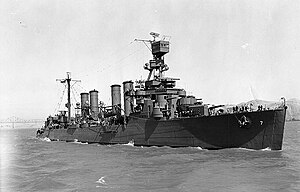 USS Raleigh (July 1942)
| |
| History | |
|---|---|
| Name | Raleigh |
| Namesake | City of Raleigh, North Carolina |
| Ordered | 29 August 1916 |
| Awarded |
|
| Builder | Bethlehem Shipbuilding Corporation's Fore River Shipyard, Quincy, Massachusetts |
| Laid down | 16 August 1920 |
| Launched | 25 October 1922 |
| Sponsored by | Miss Jennie Proctor |
| Completed | 1 August 1921 |
| Commissioned | 6 February 1924 |
| Decommissioned | 2 November 1945 |
| Stricken | 28 November 1945 |
| Identification |
|
| Honors and awards | |
| Fate | Sold for scrap, 27 February 1946 |
| General characteristics (as built)[1][2] | |
| Class and type | Omaha-class light cruiser |
| Displacement | |
| Length | |
| Beam | 55 ft (17 m) |
| Draft | 14 ft 3 in (4.34 m) (mean) |
| Installed power |
|
| Propulsion |
|
| Speed | |
| Crew | 29 officers 429 enlisted (peace time) |
| Armament |
|
| Armor |
|
| Aircraft carried | 2 × Curtiss SOC Seagulls and later 2 × Vought OS2U Kingfishers |
| Aviation facilities | |
| General characteristics (1945)[3] | |
| Armament |
|
USS Raleigh (CL-7) was the fourth Omaha-class light cruiser, originally classified as a scout cruiser, built for the United States Navy. She was the second Navy ship named for the city of Raleigh, North Carolina, the first being the protected cruiser Raleigh, commissioned in 1894, and decommissioned in 1919.
Raleigh spent most of her pre-war career in the Atlantic. Her first duty was to assist in the USAAS's first aerial circumnavigation of the world in 1924. In 1936, Raleigh joined Squadron 40-T in neutrality patrols during the Spanish Civil War where she would serve until 1938, when she would be transferred to the Pacific. This led her to be fatefully moored in Pearl Harbor at berth F-12 on the morning of 7 December 1941, where she took a torpedo in her No.2 boiler room and claimed five victories with her anti-aircraft batteries with no loss of life.